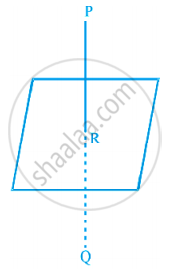Advertisements
Advertisements
प्रश्न
Find the image of the point having position vector `hat"i" + 3hat"j" + 4hat"k"` in the plane `hat"r" * (2hat"i" - hat"j" + hat"k") + 3` = 0.
उत्तर
Let the given point be `"P"(hat"i" + 3hat"j" + 4hat"k")` and Q be the image of P in the plane
`hat"r" * (2hat"i" - hat"j" + hat"k") + 3` = 0 as shown in the figure
Then PQ is the normal to the plane.
Since PQ passes through P and is normal to the given plane
So the equation of PQ is given by `vec"r" = (hat"i" + 3hat"j" + 4hat"k") + lambda(2hat"i" - hat"j" + hat"k")`
Since Q lies on the line PQ
The position vector of Q can be expressed as
`(hat"i" + 3hat"j" + 4hat"k") + lambda(2hat"i" - hat"j" + hat"k")`
i.e., `(1 + 2lambda)hat"i" + (3 - lambda)hat"j" + (4 + lambda)hat"k"`
Since R is the mid point of PQ, the position vector of R is
`([(1 + 2lambda)hat"i" + (3 - lambda)hat"j" + (4 + lambda)hat"k"] + [hat"i" + 3hat"j" + 4hat"k"])/2`
i.e., `(lambda + 1)hat"i" + (3 - lambda/2)hat"j" + (4 + lambda/2)hat"k"`
Again, since R lies on the plane `vec"r" * (2hat"i" - hat"j" + hat"k") + 3` = 0, we have
`{(lambda + 1)hat"i" + (3 - lambda/2)hat"j" + (4 + lambda/2)hat"k"} * (2hat"i" - hat"j" + hat"k") + 3` = 0
⇒ λ = –2
Hence, the position vector of Q is `(hat"i" + 3hat"j" + 4hat"k") -2(2hat"i" - hat"j" + hat"k")`
i.e. `-3hat"i" + 5hat"j" + 2hat"k"`.
APPEARS IN
संबंधित प्रश्न
In following cases, determine the direction cosines of the normal to the plane and the distance from the origin.
2x + 3y – z = 5
Find the equation of the plane with intercept 3 on the y-axis and parallel to ZOX plane.
Find the coordinates of the point where the line through (5, 1, 6) and (3, 4, 1) crosses the ZX − plane.
The planes: 2x − y + 4z = 5 and 5x − 2.5y + 10z = 6 are
(A) Perpendicular
(B) Parallel
(C) intersect y-axis
(C) passes through `(0,0,5/4)`
If the axes are rectangular and P is the point (2, 3, −1), find the equation of the plane through P at right angles to OP.
Find the intercepts made on the coordinate axes by the plane 2x + y − 2z = 3 and also find the direction cosines of the normal to the plane.
Write the normal form of the equation of the plane 2x − 3y + 6z + 14 = 0.
Find the equation of a plane which is at a distance of \[3\sqrt{3}\] units from the origin and the normal to which is equally inclined to the coordinate axes.
Find the value of λ such that the line \[\frac{x - 2}{6} = \frac{y - 1}{\lambda} = \frac{z + 5}{- 4}\] is perpendicular to the plane 3x − y − 2z = 7.
Write the plane \[\vec{r} \cdot \left( 2 \hat{i} + 3 \hat{j} - 6 \hat{k} \right) = 14\] in normal form.
Write a vector normal to the plane \[\vec{r} = l \vec{b} + m \vec{c} .\]
Write the vector equation of the line passing through the point (1, −2, −3) and normal to the plane \[\vec{r} \cdot \left( 2 \hat{i} + \hat{j} + 2 \hat{k} \right) = 5 .\]
Find the vector equation of a plane which is at a distance of 5 units from the origin and its normal vector is \[2 \hat{i} - 3 \hat{j} + 6 \hat{k} \] .
The equation of the plane \[\vec{r} = \hat{i} - \hat{j} + \lambda\left( \hat{i} + \hat{j} + \hat{k} \right) + \mu\left( \hat{i} - 2 \hat{j} + 3 \hat{k} \right)\] in scalar product form is
The equations of x-axis in space are ______.
Find the equation of a plane which is at a distance `3sqrt(3)` units from origin and the normal to which is equally inclined to coordinate axis.
The unit vector normal to the plane x + 2y +3z – 6 = 0 is `1/sqrt(14)hat"i" + 2/sqrt(14)hat"j" + 3/sqrt(14)hat"k"`.
Find the vector equation of a plane which is at a distance of 7 units from the origin and which is normal to the vector `3hati + 5hatj - 6hatk`
What will be the cartesian equation of the following plane. `vecr * (hati + hatj - hatk)` = 2
In the following cases find the c9ordinates of foot of perpendicular from the origin `2x + 3y + 4z - 12` = 0
Find the vector and cartesian equations of the planes that passes through (1, 0, – 2) and the normal to the plane is `hati + hatj - hatk`
